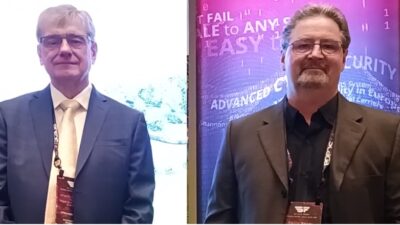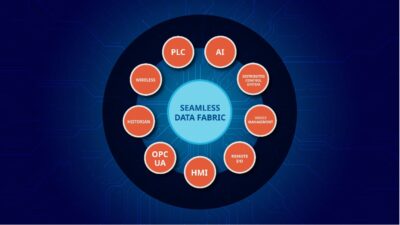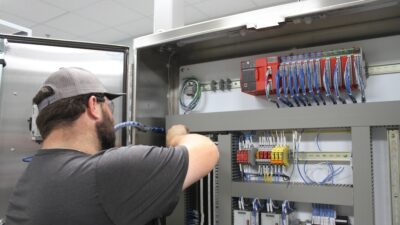Once control engineers or system integrators have designed a control system and decided what instruments, controllers, PLCs, and associated electronics/communication paraphernalia will be required to make it function, the search for "real estate" in which to house the more delicate components begins.
Once control engineers or system integrators have designed a control system and decided what instruments, controllers, PLCs, and associated electronics/communication paraphernalia will be required to make it function, the search for ‘real estate’ in which to house the more delicate components begins. For the most part, everything-delicate or not-goes into some kind of box.
The reasons for using enclosures range from housekeeping to explosion protection. Whether the application is continuous or discrete manufacturing, even the simplest installations are made up of many interconnected components. Simply providing an enclosed ‘mounting’ on which to wire a control loop neatly and conveniently is the basic function of most enclosures. Protecting instruments, controllers, and actuators from the manufacturing environment and, in some cases, where the manufacturing environment is flammable or explosive, protecting the environment from them, represents more advanced functionality.
Take your pick
Enclosures are commercially available in a wide variety of materials. According to a recent Control Engineering /Cahners Research survey, carbon steel, is still the most purchased variety at 73%. Of respondents, 61% purchased stainless steel, 38% fiberglass, 36% aluminum, and 27% engineered plastic. The survey of 10,000 Control Engineering subscribers in April had an 8% response.
Advances in nonmetallic materials have contributed to their increased popularity in enclosures. Lighter than steel, they were structurally inferior to metallic enclosures. However, in smaller sizes, nonmetallic boxes now compete favorably in UL/CSA mechanical tests.
Bill Southard, P.E., president of system integrator, DST Controls (Benicia, Calif.), says, ‘Fiberglass, polycarbonate, and ABS enclosures are usually only used in corrosive environments. Lighter and cheaper than stainless steel, they lack its structural strength and, as such, are limited in size to 6 ft2. An exception is fiberglass enclosures, which can be quite large-making you feel like you are wiring inside a Port-a-Potty.’
Molded products have other advantages that make them desirable substitutes for conventional fabricated metal enclosures. In general, nonmetallic enclosures do not conduct, which eliminates the need for box (but not component) grounding. However, a static charge can build up on their surfaces, which can discharge and cause arcing-an unacceptable situation in hazardous locations. Recent material developments include an antistatic fiberglass material that allows static to run to ground, while retaining the nonconductive nature of the box. This prevents stray current from the electrical components within from leaking to the surface of the enclosure.
Additionally, molded enclosures offer generously rounded corners and inside radii that are easy to hose, steam, or scrub down in sanitary applications. ‘Because of the molded nature of the boxes, they can usually be sealed better against the elements than steel enclosures,’ adds Mr. Southard.
Heavy metal applications
Even with nonmetallic enclosures making advances into specialty applications, steel still accounts for the greater majority of applications. Structurally, both carbon and stainless steel have plenty of structural strength for all applications. Cheap and tough, they are heavy-probably their biggest drawback, especially in larger sizes. Aluminum enclosures can be used in applications where weight is an issue. However, these enclosures do not have the strength of their steel counterparts.
Next to its strength and inherent nonflammability, the greatest advantage of the metal enclosure is ease of fabrication, which accounts for their low initial cost, ready availability, and the wide variety of types and styles. Additionally, when required, custom, highly aesthetic applications are easily fabricated using simple manufacturing techniques, such as brake shearing/bending/forming, welding, and painting/powder coating.
Although the looks of indoor applications survive well under most environmental conditions, DST Controls’ Bill Southard is quick to respond that, ‘Despite its durability, a carbon steel enclosure can and will rust no matter how well it is painted if left exposed to the elements.’ To put it another way, beauty is only skin deep, but functionality goes all the way to the bone.
Enclosure products
For more information on enclosure products, see this report online, circle the following numbers, or visit /freeinfo . For a wider listing of manufacturers, go to Control Engineering Buyer’s Guide at /buyersguide .
Convenient access
Anoka, Minn.- Proline side door adapters provide quick and easy side access to the enclosures, while maintaining environmental and structural integrity. The adapters enable users to mount a standard door on all sides of their enclosures, allowing convenient access with the turn of a handle, rather than by unbolting/ unscrewing side panels. The door adapters come in 12 sizes, from 60.59 x 19.69 in. to 84.22 x 31.498 in. They are constructed of 14-gauge steel, finished in textured gray polyester powder paint, and certified for UL508, Type 12; CSA, Type 12; IEC 529 IP55; and NEMA Type 12 environmental protection. One hundred and eight colors are available. www.hoffmanonline.com
Hoffman Engineering Circle 374
Plasma-welded enclosure line
Freeburg, Ill.- N412 Series enclosures feature a plasma welded design that eliminates grinding, thus creating an enhanced, repeatable and aesthetically pleasing product. This enclosure line also includes foam-in-place gasketing, interchangeable lift-off covers, quarter-turn latches, grounding provisions, print pocket, collar studs for mounting optional sub-panels, NEMA 4 protection, and an ANSI 61 polyester powder finish. www.hubbell-wiegmann.com
Hubbell-Wiegmann Circle 375
Extra-protection enclosures
Belding, Mich.- NightHawk extra-protection enclosures are formed from a specialized, proprietary fiberglass formulation, allowing them to be used in hazardous locations where increased safety is critical. They meet North American (UL, CAN/CSA) and European (Demko) Zone Requirements, Class I T5 temperature requirements, certification for use as a recognized component in Class I, Zone 1 and 2, and are suitable for Class I or II, Div.2 areas. The enclosures also feature maximum anti-corrosion resistance, meeting of UL 4X, 6P, and IP66 standards, a silicone gasket for high-temperature resistance, and cost efficiency versus metallic alternatives. www.stahlin.com
Stahlin Non-Metallic Enclosures Circle 377
Wall-mounted cabinets
Elkridge, Md.- The CAB PC family of wall-mounted polycarbonate cabinets is available in a range of sizes that can be machined, painted, and marked to meet custom specifications. The enclosures are UL listed as type 4, 4X, 12, and 13. In addition, the units are rated NEMA 4, 4X, 12, and IP65. All CAB PC units have enclosure flammability ratings of UL-5X, offer an optional swing out door, and feature an opaque or smoked transparent cover, quick release latches on the long or short side, and a latch or key lock door. www.fiboxusa.com
Fibox Inc. Circle 378
Widening the line
Syracuse, N.Y.- Cooper Crouse-Hinds has introduced a new line of enclosures, in stainless steel, sheet metal, and non-metallic materials, to complement its existing line of cast and fiberglass-reinforced polyester enclosures. The units are intended for both hazardous and ordinary locations. They can be purchased with factory-installed hinges and terminal blocks, breathers and drains, and have a gasket design for NEMA 4X and IP68 ratings. The new enclosures are easy to wire to increased safety terminals, and easy to install with captive stainless-steel screws. They can be modified to accommodate all wiring options. www.crouse-hinds.com
Cooper Crouse-Hinds Circle 379
Fiberglass safety terminal enclosures
Cleveland, O.- TFG Series safety enclosures provide designed-in explosion protection that prevents the possibility of excessive heat and the occurrence of an arc or spark from the Eex’e’-certified terminal blocks installed in them. This protection is accomplished by limiting the number of terminal blocks and current, maintaining proper electrical creepage and clearances, and preserving the security of electrical connectors. The enclosures are compression molded from fiberglass-reinforced polyester resin and are intended for both indoor and outdoor areas where dampness and highly corrosive atmospheres are present. Standard features include a memory retaining, poured-in-place silicon gasket, molded mounting feet, captive cover screws, and universal rail-mounting system. www.adalet.com
Adalet Circle 380
Large cabinets
Bryan, O.- Ten new larger size cabinets are now available from Allied Moulded Products. Ranging in size from the 36 x 30 x 12 in. wall mount to the 72 x 49 x 25 in. double door, free-standing enclosures cabinet, the Empire Series features all fiberglass construction with a heavy-duty, continuous stainless steel hinge. The enclosures feature EDPM gaskets with a spring-steel, self-gripping core that compresses over the flange for a tight seal-so tight, in fact, that wall mount units need only three closure latches to meet NEMA 4X requirements. All meet NEMA Type 1, 2, 3, 3R, 4, 4X, 12, and 13 specs and are UL listed. www.alliedmoulded.com
Allied Moulded Products Circle 381
(Allied Moulded Products is a CSIA member as of 2/26/2015)
Array of NEMA 12 enclosures
Cumming, Ga.- AutomationDirect offers a variety of NEMA 12 industrial control enclosures. Wall-mount models are available in single-door or continuous-hinge versions, ranging in size from 4 x 4 x 3 in. to 36 x 36 x 12 in. Two-door floor-mount models are available in sizes from 60 x 48 x 12 in. to 72 x 72 x 24 in. Also offered are pushbutton enclosures in stainless-steel and non-stainless versions with one to three pushbutton cutouts. The enclosures are also UL, CSA, NEMA/EEMAC and JIC EL-1-71 certified. www.automationdirect.com
AutomationDirect.com Circle 382
Rugged, functional enclosures
Mt. Pleasant, Pa.- The latest addition to the icestation enclosure product line, Infinity enclosures, consists of the ISI-35 and ISI-65. These enclosures are said to combine ease of installation and use with the ruggedness required for harsh manufacturing environments. They require only 5 ft2of floor space. Infinity enclosures include a dual-level, roll-out keyboard enclosure with integrated mouse pad and mouse storage area; a tool-less bottom-mounted split panel for ease of cable access; and an extra-large tempered glass window. Also included are adjustable, ventilated, shock-mounted shelves and field-upgradeable thermal management. The NEMA 12 rating of the main enclosure is not compromised when the dual-level surface is extended. www.itsenclosures.com
ITSEnclosures Circle 383
Rack supports heavy equipment
Willoughby, O.- Double Rack is an aluminum open rack said to provide more strength and durability for extra heavy equipment, yet is lightweight. Available in two models, each has an overall length of 84 in. and an overall width of 20.25 in. Depths available are adjustable from 15 to 21 in. and 22 to 35in., depending on the model selected. The racks feature four-post construction with dual mounting surfaces along with adjustable depths. Adjustable depth extenders provide wiring ladder and cableway mounting capability. www.budind.com
Bud Industries Inc. Circle 384
We’ve Got You Covered
Respondents use enclosures for equipment in the following ways.
| Types of Protection | Computor or Workstation | PLC | DCS | Instrumentation | Net-working | HMI |
| Dust-proof | 63% | 78% | 30% | 66% | 31% | 51% |
| Waterproof | 43% | 71% | 23% | 73% | 22% | 45% |
| Explosion-proof | 16% | 37% | 29% | 68% | 8% | 21% |
| Washdown-resistant | 39% | 67% | 21% | 73% | 19% | 44% |
| EMI/RFI shielding | 52% | 57% | 25% | 61% | 27% | 33% |
| A/C cooling | 58% | 70% | 27% | 35% | 19% | 30% |
| Heating | 36% | 62% | 23% | 47% | 16% | 27% |
| Office level/non-hardened | 76% | 28% | 21% | 20% | 37% | 31% |
| Source: Control Engineering and Cahners Research | ||||||
| Author Information |
| Dick Johnson, senior editor [email protected] |


